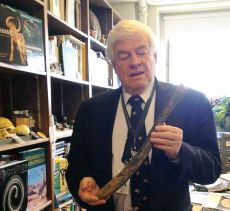Evolutionary Psychology
Of Penis Bones and Shamans
Hardening evidence for a new explanation of Adam’s “rib”
Posted December 15, 2014

Many mammals have a bone in the penis that augments stiffening for copulation. Comparative studies by Alan Dixson and colleagues revealed that copulation generally tends to last longer as the penis bone (baculum) increases in length. Mammals possessing a penis bone include the great majority of primates along with most bats, rodents, carnivores and insectivores. But a few scattered exceptions occur among primates. Tarsiers and some New World monkeys (e.g. spider monkeys) lack a penis bone, and the same is true of humans. As all apes possess a small baculum, the most likely explanation for its absence in humans is that it completely disappeared at some stage during the evolution of our lineage.
Was Adam’s “rib” his penis bone”?
In 2001, Scott Gilbert and Ziony Zevit proposed a new interpretation for the figurative biblical account of Eve’s creation with a bone taken from Adam’s body. In the English version of the Bible the ancient Hebrew word tzela (also rendered as tsela) was translated as “rib”, but it actually has a number of alternative meanings, including a strut of some kind. Gilbert and Zevit reasonably proposed that tzela possibly referred to Adam’s baculum instead. Whereas a man’s skeleton, just like a woman’s, has a complete set of twelve pairs of ribs, the penis bone is really lacking. (See my September 3, 2013 post: An Acute Sense of Loss?)
Biologically speaking, the new explanation for Adam’s “rib” suggested by Gilbert and Zevit has an immediate appeal at first sight. But, in my 2013 book on the evolution of human reproduction, I had to admit in all honesty to a potential flaw: How could the originators of the biblical story of Eve’s creation have known that humans are exceptional in lacking a penis bone? In addition to the exceptions among primates, numerous other placental mammal species lack a baculum. This is true, for instance, of rabbits, treeshrews, elephants, sea cows, all hoofed mammals (both odd-toed and even-toed), dolphins and whales. As far as domestic beasts in biblical times are concerned, many are hoofed mammals that consistently lack a penis bone. Although potentially relevant carnivores do have one, it is quite small in cats and conspicuous only in dogs. I concluded that the notion that a bone had been lost from the human penis could only have come from knowledge of the anatomy of dogs. Yet it was difficult to see how that connection might have been made.
A fossilized walrus baculum. The longest on record is 4 feet. Of serendipity and shamans

A fossilized walrus baculum. The longest on record is 4 feet.
Of serendipity and shamans
Two factors recently prompted me to reconsider my skepticism regarding loss of the human penis bone and the biblical tale of Eve’s creation. The first impetus came from reading a very interesting blog posting on the topic of serendipity, defined as “the occurrence and development of events by chance in a happy or beneficial way”. In fact, I am currently benefiting from a Fellowship at the Institute for Advanced Study (Wissenschaftskolleg) in Berlin, with plenty of freedom to probe more deeply into diverse aspects of human reproductive biology. The second, more direct, stimulus came serendipitously from a now completed translation project with my son Oliver. Over the summer, we joined forces to translate Jean Clottes’ book Pourquoi l’art paleolithique from French into English. In this fascinating text, Clottes presents a case for his controversial hypothesis linking Palaeolithic cave art to shamanic rites. Regardless of whether the reader is convinced by his carefully marshalled arguments, the book is an enthralling compendium of information from Clottes’ on-site investigations on five continents of surviving connections between shamanism and rock art. In the chapter reporting information from his extensive travels, Clottes mentions in passing that for a Siberian shaman the bear was the most important animal and that its penis bone was a symbol of power. Bears are widely regarded as rather special because of a tendency to walk around on their hindlimbs. Yet I had never considered bears as a possible source of ancient knowledge about penis bones in the Middle East.
Nowadays, no bears are present in Israel or neighbouring regions; but they did once occur there. The Syrian brown bear, a relatively small-bodied subspecies now classed as endangered, still survives in Transcaucasia and in Iran, Iraq and Turkey. However, it became extinct in historical times in Egypt, Israel, Lebanon and (more recently) Syria. In Israel, the brown bear was still present around a century ago and subsequently went extinct. In fact, bears are repeatedly mentioned in the Bible, so the animal was clearly well known in biblical times. So it is possible that bears once played an important part in shamanic rites in the Middle East in pre-Christian times, in which case ceremonies would surely have included their penis bones. It is therefore entirely conceivable that the absence of a penis bone in men was common knowledge because a relatively large bone was present in bears and actually used in rituals of a religious nature. No information is available on the size of the penis bone in the Syrian brown bear, but in brown bears generally it is about five inches in length. In an extinct Miocene bear found in cave deposits in Spain, five penis bones were recovered with an average length of nine inches. So ancient shamans using caves for ceremonies might possibly have come across unusually large bacula from fossil bears. In any event, the connection between shamanic rites and penis bones of bears does make the Gilbert/Zevit hypothesis far more plausible than I thought a year ago. Now that is serendipity in action.
References
Abella,J., Valenciano,A., Pérez-Ramos,A., Montoya,P. & Morales,J. (2013) On the socio-sexual behaviour of the extinct ursid Indarctos arctoides: An approach based on Its baculum size and morphology. PLoS ONE 8(9): e73711:1-5
Dixson, A.F. (1987) Baculum length and copulatory behavior in primates. American Journal of Primatology 13:51-60.
Dixson, A.F. (1995) Baculum length and copulatory behaviour in carnivores and pinnipeds (Grand Order Ferae). Journal of Zoology, London 235:67-76.
Dixson, A.F., Nyholt, J. & Anderson, M.J. (2004) A positive relationship between baculum length and prolonged intromission patterns in mammals. Acta Zoologica Sinica, 50:490-503.
Gilbert, S.F. & Zevit, Z. (2001) Congenital human baculum deficiency: The generative bone of Genesis 2: 21-23. American Journal of Medical Genetics 101:284-285.
Hosken, D.J., Jones, K.E., Chipperfield, K. & Dixson, A.F. (2001) Is the bat os penis sexually selected? Behavioral Ecology and Sociobiology 50:450-460.
Martin, R.D. (2014) How We Do It: The Evolution of Human Reproduction. New York: Basic Books.
Ramm, S.A. (2007) Sexual selection and genital evolution in mammals: A phylogenetic analysis of baculum length. American Naturalist 169:360-369.
Stockley, P. (2012) The baculum. Current Biology 22:R1032-R1033.
See also (particularly recommended):
Map of Life - "Baculum (penile bone) in mammals"
http://www.mapoflife.org/topics/topic_203_Baculum-(penile-bone)-in-mamm…




